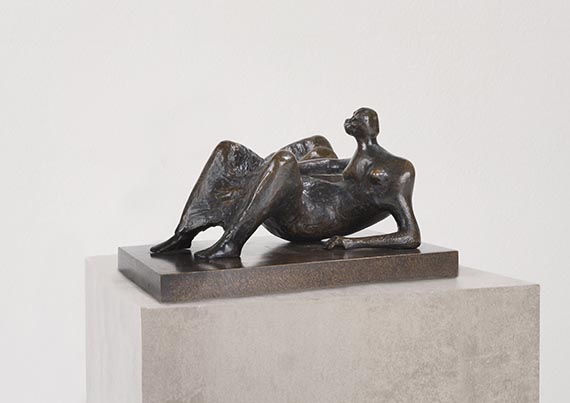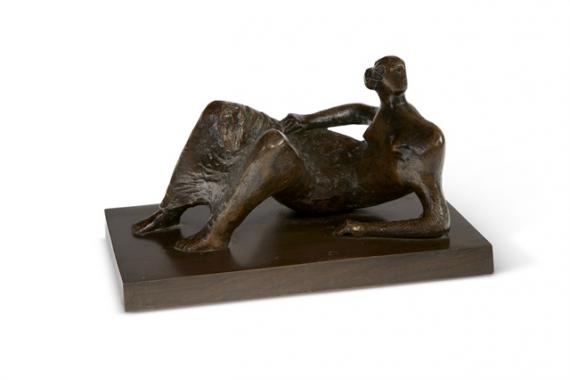Verso
Autre image
Autre image
Autre image
Autre image
124000458
Henry Moore
Maquette for Reclining Figure: Angles, 1975.
Bronze with brown patina
Estimation: € 100,000 / $ 107,000
Les informations sur la commission d´achat, les taxes et le droit de suite sont disponibles quatre semaines avant la vente.
Maquette for Reclining Figure: Angles. 1975.
Bronze with brown patina.
With the signature and the embossed number on the rear of the base. One of nine copies (plus one artist copy). Height: 11.2 cm (4.4 in). Including base: 13,5 x 23,3 x 15,2 cm (5,3 x 9,2 x 6 in).
Cast by The Morris Singer Foundry Ltd., Basingstoke, in 1975. [CH]
More works from the Dr. Maier-Mohr Collection are offered in our Evening Sale on Friday, June 7, 2024, as well as in our Modern Art Day Sale on Saturday, June 8, 2024 (see catalog “Dr. Theo Maier-Mohr - A Private Collection”).
• Maquette for the 1979 work "Reclining Figure: Angles" (at the Hakone Open Air Museum, Japan, and the Art Gallery of New South Wales, Sydney).
• From the 1920s until his death in 1984, the reclining figure was one of the most important themes in Henry Moore's oeuvre.
• The distorted limbs and proportions of "Reclining Figure: Angles" offer space for a multitude of asymmetrical forms and various acute angles.
• Moore finds inspiration in the Chac Mo'ol, a group of stone sculptures in Mesoamerica (dat. ca. 900-1200).
• Part of the same German private collection for almost 50 years.
• Another cast of this maquette is in the Art Gallery of Ontario in Toronto.
The work is documented at the Henry Moore Foundation, Hertfordshire, with the number LH 673.
PROVENANCE: Fischer Fine Art Ltd., London.
Dr. Theo Maier-Mohr Collection (acquired from the above in 1976).
Ever since family-owned.
LITERATURE: Alan Bowness, Henry Moore. Sculpture and Drawings, vol. 5 (1974-1980), London 1983, no. 673 (illu. in black and white, different copy).
"The reclining figure gives most freedom compositionally and spatially. The seated figure has to have something to sit on. You can't free it from its pedestal. A reclining figure can recline on any surface. It is free and stable at the same time [..] also, it has repose, it suits me."
Henry Moore, quoted from: Henry Moore Foundation, Reclining Figure: Angles (Sculpture Summary), https://catalogue.henry-moore.org/objects/25963/reclining-figure-angles?ctx=1eb28ed4f
a6fcdd4d6bb964a374c5203f246443b&idx=6
Bronze with brown patina.
With the signature and the embossed number on the rear of the base. One of nine copies (plus one artist copy). Height: 11.2 cm (4.4 in). Including base: 13,5 x 23,3 x 15,2 cm (5,3 x 9,2 x 6 in).
Cast by The Morris Singer Foundry Ltd., Basingstoke, in 1975. [CH]
More works from the Dr. Maier-Mohr Collection are offered in our Evening Sale on Friday, June 7, 2024, as well as in our Modern Art Day Sale on Saturday, June 8, 2024 (see catalog “Dr. Theo Maier-Mohr - A Private Collection”).
• Maquette for the 1979 work "Reclining Figure: Angles" (at the Hakone Open Air Museum, Japan, and the Art Gallery of New South Wales, Sydney).
• From the 1920s until his death in 1984, the reclining figure was one of the most important themes in Henry Moore's oeuvre.
• The distorted limbs and proportions of "Reclining Figure: Angles" offer space for a multitude of asymmetrical forms and various acute angles.
• Moore finds inspiration in the Chac Mo'ol, a group of stone sculptures in Mesoamerica (dat. ca. 900-1200).
• Part of the same German private collection for almost 50 years.
• Another cast of this maquette is in the Art Gallery of Ontario in Toronto.
The work is documented at the Henry Moore Foundation, Hertfordshire, with the number LH 673.
PROVENANCE: Fischer Fine Art Ltd., London.
Dr. Theo Maier-Mohr Collection (acquired from the above in 1976).
Ever since family-owned.
LITERATURE: Alan Bowness, Henry Moore. Sculpture and Drawings, vol. 5 (1974-1980), London 1983, no. 673 (illu. in black and white, different copy).
"The reclining figure gives most freedom compositionally and spatially. The seated figure has to have something to sit on. You can't free it from its pedestal. A reclining figure can recline on any surface. It is free and stable at the same time [..] also, it has repose, it suits me."
Henry Moore, quoted from: Henry Moore Foundation, Reclining Figure: Angles (Sculpture Summary), https://catalogue.henry-moore.org/objects/25963/reclining-figure-angles?ctx=1eb28ed4f
a6fcdd4d6bb964a374c5203f246443b&idx=6
In a great range of postures, poses and forms, the human figure is at the heart of Henry Moore's oeuvre. The artist began to explore the reclining human figure in his carved wood or stone sculptures, the so-called "Carvings" as early as in the 1920s. An example of this is "Reclining Figure" from 1929 (stone, Leeds Museums and Galleries). Until his death in 1986, the motif recurred in many of his astonishingly diverse sculptures and drawings, making it one of the most important themes of his entire artistic oeuvre: "There are three recurring themes in my work: 'Mother and Child', the 'Reclining Figure' and 'Inner and Outer Forms'. In some figures two or even all three themes are combined" (Henry Moore, in ex. cat: Henry Moore. Ursprung und Vollendung, Munich 1996, p. 12) In some works, the artist combines the "Reclining Figure" with the mother-and-child theme, for example in "Draped Reclining Mother and Baby" (1983, bronze, J. Paul Getty Museum, Los Angeles). The diverse variations demonstrate the extraordinary spatial and compositional freedom that Moore explores in the "Reclining Figures", allowing him to develop ever new forms on the same subject. "There are three basic poses for the human figure: standing, sitting and reclining. [..] Between [the seated or reclining figure] there are enough variations to keep a sculptor busy all his life. [..] Of the three positions, however, the reclining one offers the greatest freedom in terms of composition and space. [..] It is free and stable at the same time. It fits in with my conviction that sculpture should be something permanent, something made for eternity." (Henry Moore, quoted from: ex. cat. Henry Moore. Ursprung und Vollendung, Munich 1996, p. 71)
In their forms, but also in their vitality and intensity, Henry Moore's works combine elements from landscape and nature. On the one hand, the artist describes his ability to humanize nature, that is to discover the human figure in landscape, but also in organic things, in stones, shells and driftwood. On the other hand, Moore breathes a certain feeling of nature and landscape into his figures: Their at times quite massive torsos resemble tree trunks or boulders and the monumental outdoor sculptures, with their rounded limbs, are often reminiscent of the gently rolling hills (cf. exhib. "Vitality: The Human Landscapes of Henry Moore", 2023, Henry Moore Foundation, Perry Green).
The vitality inherent in the sculptures, as in the present work, is partly a result of the figure's dynamic pose. Leaning on her left arm, her weight shifted to the left, both legs bent and gazing into the distance, the reclining figure does not appear like a passive observer, instead her modern formal language and upright posture convey attention, self-confidence and activity. [CH]
In their forms, but also in their vitality and intensity, Henry Moore's works combine elements from landscape and nature. On the one hand, the artist describes his ability to humanize nature, that is to discover the human figure in landscape, but also in organic things, in stones, shells and driftwood. On the other hand, Moore breathes a certain feeling of nature and landscape into his figures: Their at times quite massive torsos resemble tree trunks or boulders and the monumental outdoor sculptures, with their rounded limbs, are often reminiscent of the gently rolling hills (cf. exhib. "Vitality: The Human Landscapes of Henry Moore", 2023, Henry Moore Foundation, Perry Green).
The vitality inherent in the sculptures, as in the present work, is partly a result of the figure's dynamic pose. Leaning on her left arm, her weight shifted to the left, both legs bent and gazing into the distance, the reclining figure does not appear like a passive observer, instead her modern formal language and upright posture convey attention, self-confidence and activity. [CH]
124000458
Henry Moore
Maquette for Reclining Figure: Angles, 1975.
Bronze with brown patina
Estimation: € 100,000 / $ 107,000
Les informations sur la commission d´achat, les taxes et le droit de suite sont disponibles quatre semaines avant la vente.




 Lot 124000458
Lot 124000458 
